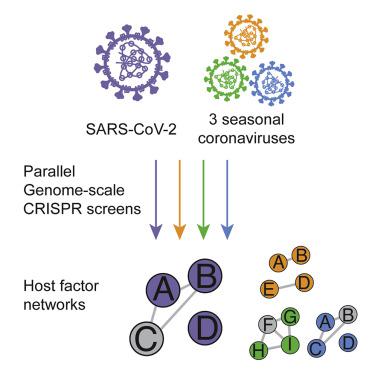Cell ( IF 45.5 ) Pub Date : 2020-12-09 , DOI: 10.1016/j.cell.2020.12.006 William M Schneider 1 , Joseph M Luna 1 , H-Heinrich Hoffmann 1 , Francisco J Sánchez-Rivera 2 , Andrew A Leal 3 , Alison W Ashbrook 1 , Jérémie Le Pen 1 , Inna Ricardo-Lax 1 , Eleftherios Michailidis 1 , Avery Peace 1 , Ansgar F Stenzel 4 , Scott W Lowe 2 , Margaret R MacDonald 1 , Charles M Rice 1 , John T Poirier 3

|
The coronavirus disease 2019 (COVID-19) pandemic has claimed the lives of over one million people worldwide. The causative agent, severe acute respiratory syndrome coronavirus 2 (SARS-CoV-2), is a member of the Coronaviridae family of viruses that can cause respiratory infections of varying severity. The cellular host factors and pathways co-opted during SARS-CoV-2 and related coronavirus life cycles remain ill defined. To address this gap, we performed genome-scale CRISPR knockout screens during infection by SARS-CoV-2 and three seasonal coronaviruses (HCoV-OC43, HCoV-NL63, and HCoV-229E). These screens uncovered host factors and pathways with pan-coronavirus and virus-specific functional roles, including major dependency on glycosaminoglycan biosynthesis, sterol regulatory element-binding protein (SREBP) signaling, bone morphogenetic protein (BMP) signaling, and glycosylphosphatidylinositol biosynthesis, as well as a requirement for several poorly characterized proteins. We identified an absolute requirement for the VMP1, TMEM41, and TMEM64 (VTT) domain-containing protein transmembrane protein 41B (TMEM41B) for infection by SARS-CoV-2 and three seasonal coronaviruses. This human coronavirus host factor compendium represents a rich resource to develop new therapeutic strategies for acute COVID-19 and potential future coronavirus pandemics.
中文翻译:

SARS-CoV-2 和泛冠状病毒宿主因子网络的基因组规模鉴定
2019 年冠状病毒病 (COVID-19) 大流行夺去了全世界超过 100 万人的生命。病原体,严重急性呼吸系统综合症冠状病毒 2 (SARS-CoV-2),是冠状病毒科的成员可引起不同严重程度呼吸道感染的病毒。在 SARS-CoV-2 和相关冠状病毒生命周期中选择的细胞宿主因素和途径仍然不明确。为了解决这一差距,我们在 SARS-CoV-2 和三种季节性冠状病毒(HCoV-OC43、HCoV-NL63 和 HCoV-229E)感染期间进行了基因组规模的 CRISPR 敲除筛选。这些筛选揭示了具有泛冠状病毒和病毒特异性功能作用的宿主因素和途径,包括对糖胺聚糖生物合成、甾醇调节元件结合蛋白 (SREBP) 信号传导、骨形态发生蛋白 (BMP) 信号传导和糖基磷脂酰肌醇生物合成的主要依赖性。作为几种特征不佳的蛋白质的要求。我们确定了对 VMP1、TMEM41、和含有 TMEM64 (VTT) 结构域的蛋白跨膜蛋白 41B (TMEM41B) 用于感染 SARS-CoV-2 和三种季节性冠状病毒。这个人类冠状病毒宿主因子纲要代表了为急性 COVID-19 和潜在的未来冠状病毒大流行开发新治疗策略的丰富资源。











































 京公网安备 11010802027423号
京公网安备 11010802027423号